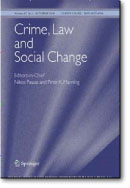Squeezing the Balloon?

United States Air Interdiction and the Restructuring of the South American Cocaine Industry in the 1990s
Autor(en): Cornelius Friesendorf
Journaltitel: Crime, Law and Social Change
Band: 44
Ausgabe: 1
Seiten: 35-78
Verlag(e): Springer
Publikationsjahr: 2006
